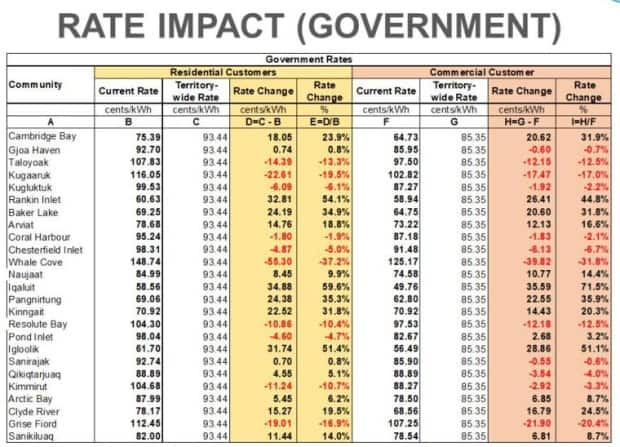Qulliq Energy proposes to cut business, homeowner power bills and hike gov't rates

The Qulliq Energy Corporation (QEC) is proposing a bold change to what customers in Nunavut pay for power, in the hopes it decreases the overall cost of living across the territory.
In an application to the Utility Rates Review Council — which determines power rates in the territory — QEC is proposing to establish a territory-wide power rate for its various customers, across all communities.
Right now, residential customers in all communities pay the same rates up to a certain point. That's because the government subsidizes the first 1,000 kilowatt hours of electricity between October and March, and 700 kilowatt hours from April to September.
Once customers go above those usage limits, they face different costs based on "base rates" set for each community which vary widely across the territory. For example, when people in Whale Cove go over the subsidized amount of power, they pay higher rates than people in Iqaluit who do the same.
QEC is instead proposing that residential customers in all communities pay the same subsidized and base rates.
QEC is proposing a 5.1 per cent increase to the existing subsidized rates. But the current base rates — which are the non-subsidized rates people pay after they've exceeded electricity limits — would decrease in every community except Iqaluit.

Big cuts to commercial rates
QEC is proposing the same for commercial customers. Currently, commercial customers don't get any subsidy and every base rate varies by community.
QEC wants instead to move every community to the same commercial rate. The effect would be to lower commercial power rates in every community in Nunavut except Iqaluit.
Iqaluit would instead see a 5.1 per cent increase, while the rest of the communities will collectively see a rate reduction of 38.44 per cent.
And while on the surface it may seem Iqaluit is propping up the rest of the communities, the rate increase to Iqaluit isn't enough to overcome the deficit created by lowering the rates in the rest of Nunavut's communities.
To cover that shortfall, QEC is proposing to substantially hike rates for government customers.
Why QEC needs to do this
QEC says it's facing a $6.6 million shortfall for the 2022-23 fiscal year under the current rates. It says it needs a 5.1 per cent increase to rates across all communities to cover it.
That would mean Iqaluit's power rate would go up by 5.1 per cent either way.
Under the proposed changes, however, Nunavut's communities would see a substantial decrease to their residential base rates, rather than a uniform increase. QEC says commercial rates would also be made more fair under the proposed plan, rather than more unequal if a 5.1 per cent hike were applied to the different rates already in place.
In particular, QEC officials hope slashing the rates for commercial customers in the communities will help with the cost of doing business in Nunavut — savings which it expects will be passed on to customers.
QEC officials, who sat down with CBC News to go through the changes in detail, explained how government funding programs already disadvantage communities with higher costs of living. In particular, Nunavut income support and federal pension plans don't adjust their payments based on where someone lives.
QEC argues billing communities different power rates disadvantages Nunavummiut who live in higher-cost communities, not just for home electricity but by increasing the cost of doing business there too.

Government increases
As mentioned, QEC is proposing to hike the cost of government power rates — among all three levels of government — to make up for the overall cuts in residential and commercial rates.
In Iqaluit, commercial government customers stand to see a 71.5 per cent hike in rates, followed by 51.5 per cent in Igloolik, and 44.8 per cent in Rankin Inlet.
Eight of the top nine rate increases for commercial government customers are in decentralized communities, except Clyde River, which would see a 24.5 per cent hike.
At first glance, decentralized communities seem to be carrying the load under the proposed changes. But QEC says the current rate structure was established before division from the N.W.T., and those rates evolved as a matter of uniform percentage increases over time. Bringing every community under the same rate now breaks the cycle of uniform rate adjustments.
Overall, QEC says the net cost to the Government of Nunavut under the proposed changes would be $6.2 million per year, and $1.7 million to municipal governments. The federal government would pay $486,000 more a year.
The Utility Rates Review Council is now in the process of reviewing public feedback to provide advice to the minister on the proposed changes. Nunavummiut can weigh in by emailing their comments to URRC@gov.nu.ca by on June 17.


